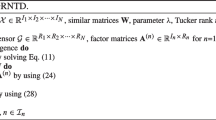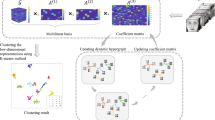Abstract
Non-negative Tucker decomposition (NTD) has received much attention due to its efficient processing of high-dimensional non-negative data. To preserve the intrinsic geometric structure of the data, various graph regularization NTD methods have been proposed. However, most existing methods rely on single graph regularization, limiting their flexibility and adaptability, since a single graph may not adequately capture the intrinsic manifold structure of various datasets. To address this problem, this paper introduces an auto-weighted multiple graph structure as the regularizer for NTD, and then proposes a novel method called auto-weighted multiple graph regularized non-negative Tucker decomposition (AMGRNTD). The AMGRNTD method utilizes a linear combination of multiple simple graphs to more effectively preserve the intrinsic manifold structure of the original data, offering greater applicability to practical problems than single graph-based methods. Furthermore, the AMGRNTD method automatically learns an optimal weight for each graph without additional parameters. Experimental results on four real-world datasets demonstrate that the proposed method achieves better performance in image clustering than some existing state-of-the-art graph-based regularization methods.






Similar content being viewed by others
Data Availability
The datasets generated during the current study are available from the corresponding author upon reasonable request.
Code Availability
The code is available upon reasonable request and addressed to the corresponding author.
Notes
References
Panagakis, Y., Kossaifi, J., Chrysos, G.G., Oldfield, J., Nicolaou, M.A., Anandkumar, A., Zafeiriou, S.: Tensor methods in computer vision and deep learning. Proc. IEEE 109(5), 863–890 (2021)
Sandoval, B., Barocio, E., Korba, P., Sevilla, F.R.S.: Three-way unsupervised data mining for power system applications based on tensor decomposition. Electric Power Systems Res. 187, 106431 (2020)
Sidiropoulos, N.D., De Lathauwer, L., Fu, X., Huang, K., Papalexakis, E.E., Faloutsos, C.: Tensor decomposition for signal processing and machine learning. IEEE Trans. Signal Process. 65(13), 3551–3582 (2017)
Salem, N., Hussein, S.: Data dimensional reduction and principal components analysis. Proc. Comput. Sci. 163, 292–299 (2019)
Martinez, A.M., Kak, A.C.: PCA versus LDA. IEEE Trans. Pattern Anal. Mach. Intell. 23(2), 228–233 (2001)
Zhou, G., Cichocki, A., Zhang, Y., Mandic, D.P.: Group component analysis for multiblock data: common and individual feature extraction. IEEE Trans. Neural Netw. Learning Syst. 27(11), 2426–2439 (2015)
Lee, D.D., Seung, H.S.: Learning the parts of objects by non-negative matrix factorization. Nature 401(6755), 788–791 (1999)
Cai, D., He, X., Han, J., Huang, T.S.: Graph regularized non-negative matrix factorization for data representation. IEEE Trans. Pattern Anal. Mach. Intell. 33(8), 1548–1560 (2010)
Geng, B., Tao, D., Xu, C., Yang, L., Hua, X.-S.: Ensemble manifold regularization. IEEE Trans. Pattern Anal. Mach. Intell. 34(6), 1227–1233 (2012)
Wang, J.J.Y., Bensmail, H., Gao, X.: Multiple graph regularized non-negative matrix factorization. Pattern Recogn. 46(10), 2840–2847 (2013)
Nie, F., Li, J., Li, X.: Parameter-free auto-weighted multiple graph learning: a framework for multiview clustering and semi-supervised classification. IJCAI 9, 1881–1887 (2016)
Shu, Z., Wu, X., Fan, H., Huang, P., Wu, D., Hu, C., Ye, F.: Parameter-less auto-weighted multiple graph regularized non-negative matrix factorization for data representation. Knowl. Based Syst. 131, 105–112 (2017)
Tucker, L.R.: Some mathematical notes on three-mode factor analysis. Psychometrika 31(3), 279–311 (1966)
Yang, Z., Zhang, Y., Xiang, Y., Yan, W., Xie, S.: Non-negative matrix factorization with dual constraints for image clustering. IEEE Trans. Syst. Man Cybernet. Syst. 50(7), 2524–2533 (2018)
Song, H.A., Kim, B.K., Xuan, T.L., Lee, S.Y.: Hierarchical feature extraction by multi-layer non-negative matrix factorization network for classification task. Neurocomputing 165, 63–74 (2015)
Pascual-Montano, A., Carmona-Saez, P., Chagoyen, M., Tirado, F., Carazo, J.M., Pascual-Marqui, R.D.: bioNMF: a versatile tool for non-negative matrix factorization in biology. BMC Bioinformatics 7, 1–9 (2006)
Kim, Y.D., Choi, S.: Nonnegative tucker decomposition, 2007 IEEE Conference on Computer Vision and Pattern Recognition, 1–8 (2007)
Kim, Y.D., Cichocki, A., Choi, S.: Non-negative Tucker decomposition with alpha-divergence, 2008 IEEE International Conference on Acoustics, Speech and Signal Processing, 1829–1832 (2008)
Yin, W., Ma, Z.: LE &LLE regularized non-negative Tucker decomposition for clustering of high dimensional datasets. Neurocomputing 364, 77–94 (2019)
Jiang, T., Ng, M.K., Pan, J., Song, G.: Non-negative low rank tensor approximations with multidimensional image applications. Numer. Math. 153(1), 141–170 (2023)
Jiang, B., Ding, C., Tang, J., Luo, B.: Image representation and learning with graph-Laplacian Tucker tensor decomposition. IEEE Trans. Cybernet. 49(4), 1417–1426 (2018)
Li, X., Ng, M.K., Cong, G., Ye, Y., Wu, Q.: MR-NTD: manifold regularization non-negative Tucker decomposition for tensor data dimension reduction and representation. IEEE Trans. Neural Netw. Learning Syst. 28(8), 1787–1800 (2016)
Qiu, Y., Zhou, G., Zhang, Y., Xie, S.: Graph regularized non-negative Tucker decomposition for tensor data representation, ICASSP 2019-2019 IEEE International Conference on Acoustics, Speech and Signal Processing (ICASSP), 8613–8617 (2019)
Qiu, Y., Zhou, G., Wang, Y., Zhang, Y., Xie, S.: A generalized graph regularized non-negative tucker decomposition framework for tensor data representation. IEEE Trans. Cybernet. 52(1), 594–607 (2020)
Liu, Q., Lu, L., Chen, Z.: Non-negative Tucker decomposition with graph regularization and smooth constraint for clustering. Pattern Recogn. 148, 110207 (2024)
Kolda, T.G., Bader, B.W.: Tensor decompositions and applications. SIAM Rev. 51(3), 455–500 (2009)
Golub, G.H., Van Loan, C.F.: Matrix Computations–4th edition, Johns Hopkins University Press, (2013)
Teboulle, M., Vaisbourd, Y.: Novel proximal gradient methods for non-negative matrix factorization with sparsity constraints. SIAM J. Imag. Sci. 13(1), 381–421 (2020)
Li, B., Zhou, G., Cichocki, A.: Two efficient algorithms for approximately orthogonal non-negative matrix factorization. IEEE Signal Process. Lett. 22(7), 843–846 (2014)
Zhang, Y., Zhou, G., Zhao, Q., Cichocki, A., Wang, X.: Fast non-negative tensor factorization based on accelerated proximal gradient and low-rank approximation. Neurocomputing 198, 148–154 (2016)
Nazih, M., Minaoui, K., Comon, P.: Using the proximal gradient and the accelerated proximal gradient as a canonical polyadic tensor decomposition algorithms in difficult situations. Signal Process. 171, 107472 (2020)
Lee, D., Seung, H.S.: Algorithms for non-negative matrix factorization. Adv. Neural Inform. Process. Syst. 13, 535–541 (2000)
Cai, D., He, X., Han, J.: Document clustering using locality preserving indexing. IEEE Trans. Knowl. Data Eng. 17(12), 1624–1637 (2005)
Acknowledgements
The authors are very grateful to the two anonymous referees for their helpful comments and suggestions.
Funding
This work was supported by the National Natural Science Foundation of China (Nos. 12471353, 12201267), the Natural Science Foundation of Gansu Province (No. 22JR5RA559).
Author information
Authors and Affiliations
Corresponding author
Ethics declarations
Conflict of interest
The authors declare that they have no known competing financial interests or personal relationships that could have appeared to influence the work reported in this paper.
Additional information
Publisher's Note
Springer Nature remains neutral with regard to jurisdictional claims in published maps and institutional affiliations.
Rights and permissions
Springer Nature or its licensor (e.g. a society or other partner) holds exclusive rights to this article under a publishing agreement with the author(s) or other rightsholder(s); author self-archiving of the accepted manuscript version of this article is solely governed by the terms of such publishing agreement and applicable law.
About this article
Cite this article
Liu, G., Zhao, R., Zheng, B. et al. Auto-Weighted Multiple Graph Regularized Non-negative Tensor Tucker Decomposition for Clustering. J Sci Comput 102, 86 (2025). https://doi.org/10.1007/s10915-025-02817-0
Received:
Revised:
Accepted:
Published:
DOI: https://doi.org/10.1007/s10915-025-02817-0




